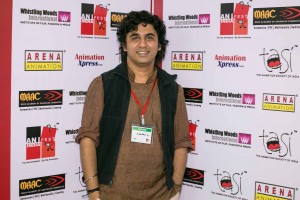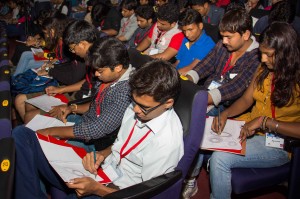It was a good session to start day 3 at Anifest India 2014. Chetan Sharma one of the founder directors of animation studio Animagic and the animator behind such awesome and award winning films such as Tripura and many a successful TV commercial on stage. It served to get the young animation students in the audience involved , engaged, and participating.

Beginning with a showreel of all the work that the studio has done, he went on to tell the audience that they should not be afraid of putting their ideas down. “There are artists who express their ideas and there are those who really put their ideas down on paper to display their art, their talent,” he said. “And there are those who are afraid of doing so. They wait for a visual development artist to translate those. But we should not be doing that, we should put down our ideas to paper. We all need to do it.”
He added that like athletes, dancers, musicians, sportsmen or boxers, who have to train every day, artists need to do the same. “Train yourselves as artists to put our ideas to paper. As kids we have all drawn, we need to bring that childlike wonder for art to our drawing. We need to let go.”
Chetan had the youngsters in the audience chant OM, at least four times. “Forget the religious significance,” he said.” In ancient India, every day they began with this chant and ended with it. It is the same sound emitted by the sun.”
He then had the audience participate in an exercise which began with them drawing circles, ovals, straight lines, eights, curved lines, free form in their notebooks– all to the strains of slow classical fusion music. He urged them, motivated them like a guru on steroids, like a maestro, like a music conductor to draw the various shapes to music.

He then shifted pace having them draw to the up-tempo strains of L.Subramanium and Ron Wagner’s Flight of the Humble bee over two repeat sessions.
At the end of the first session of fast drawing, the audience felt an almost cathartic sense of relief and they applauded spontaneously in a roar that filled the Jai Hind College auditorium.
“Oftentimes you feel jammed, your hand does not move, you feel your hands can’t move. Do this exercise of drawing lines, circles, lines and you will be free. Do it for a week, and trust me your ideas will flow to paper,” he exalted like a bible thumping preacher. “I do this regularly.”
“Drawing to music jumpstarts you,” he said. “When I started my career, I looked at earlier works, and I was overawed: would I ever be able to do what the earlier artistes and masters used to do., is what I asked myself. But you can do it. The more and more you draw the easier it becomes as you go along. A musician does not think about the next note. Hence, an artist does not think about drawing in parts, he moves flowingly expressing what he wants to draw, he moves easily.

“To know the world you have to go out and observe the world, get the experience. That takes time which brings some character to your art,” he expounded. “But the basic hygiene of doing things for an artist is designing the character, the story board. Most great artistes learn their patterns, the way their hands move, and then they break the pattern and begin again. There is a lot of stuff in their pencil mileage. This was my problem. And pencil mileage helped me get out of it.”
“All of animation is about a combination of circles, ovals, straight lines, curved lines, eights, and free form,” he elaborated “You have to revisit these regularly, the basics.”
He then demo-ed a sketch on stage of a jeans and T-shirt clad man leaning on a stick. “You have to first do the frame, and then go into the detail of the posture, the hands, the gestures,” he said. “Don’t worry about the details first.”
He then went to transform the frame drawing into a village headman with a turban, a moustache, the dhoti.
“You cannot sleep walk your way through life, on your mobile phone, or your computer You have to consciously observe, absorb,” he highlighted. “Each person sitting next to you can give you stories; they have stories to tell. They can give you fodder to be as creative as you want. You will collect life, and you will collect the ability to put it down. It’s the same thing with writing. For art to break forth, you have to clear the pathways for it burst out: for it to communicate to other people.”
He said basic drawing techniques are available through Preston Blair’s how to do animation “It still rocks. You can learn it. But you have to move on to ‘I want to create characters, I want to tell stories’,” he pointed out. “What is needed is faith in the characters, and also to get feedback, to modify them until they start speaking to you, until they come alive.”
“There is no competition if you are an aware artiste and you can express whichever way you can tell your story,” he clarified. “From a director’s point of view it is important that you know what modeling is about, and not just the technique and the technology, but the modeling. You will never be jobless, if you know the art. Take the time to learn the art to tell the story; technology will change. But you will be wanted.”

